6 Ways to Boost SaaS Free Trial Conversion Rates

Head of Growth & Product Marketing
Struggling to boost your conversion rates? Below, you’ll find simple and creative ways to increase free trial rates that go beyond adding in-app guidance or redoing your entire onboarding experience.
Free Trial Benchmarks
Before diving into methods for upping free trial conversions, it’s important to examine “typical” conversion rates. First, let’s distinguish between opt-in and opt-out free trials.
Opt-in free trials
- Enable users to get started immediately without entering their credit card information.
- Are meant to spread awareness — anyone can experience the product
- Have lower conversion rates, ranging from 14 - 25%
Opt-out free trials
- Require users to provide their payment information upfront
- Charge users when a free trial is over
- Generates more serious leads
- Higher conversion rates, hovering around 60%.
6 Ways to Boost Free Trial Conversions
Now that you understand typical conversion rates, let's break down six ways to improve your free trial conversion rate.
Way #1: Evaluate if your product is right for a free trial
The easiest way to fix a free trial conversion problem is to first evaluate if it makes sense to have a free trial.
Here are a few questions to get you thinking:
- Are your conversion rates in line with industry benchmarks? Pull your current conversion rates and compare them to the opt-in and opt-out free trial conversion rates above. How do they compare? Use this juxtaposition as a starting point for a conversation with your larger team.
- Do most users see value within a few days? Counting on users to continue using something that doesn’t generate value right away isn’t realistic. Wowing prospects from the start tends to yield more success.
- Is it difficult to set up the free trial? Free trials can come with tricky imports or other complicated setup tasks. Without a seamless setup process, you’re asking for free trial activity dropoff or worse, abandonment.
- Does it rely on private data? These days companies are getting more and more protective of their data and their customer’s data. Requiring leads to upload potentially compromising information will limit who will even sign up for a free trial.
Free trials aren’t always the best option, but that doesn’t mean you have to throw in the towel.
Freemium models or interactive product demos generate many of the same benefits of free trials without incurring as much risk.
Way #2: Conduct user research
It’s tough to design an exceptional free trial without knowing what your prospects want. The good news is that you can do some research without even turning off your free trial.
Qualitative data
1. Reach out to free trailers who didn’t convert. Ask these folks for a short interview (15 - 20 minutes) and offer up a gift card or other monetary value for their time and feedback.
2. Use a user feedback tool. Get anonymous UI feedback with tools like Userfeel, or test out messaging with Wynter.
Userfeel
- Shares your website with a panel of high-quality testers
- Starts at $30 per test
- Supports over 40 languages
- Allows you to ask unlimited screener questions
- Permits moderated or unmoderated testing
Actionable user feedback comes back in the form of videos and audio transcripts. Seeing what features unbiased users gravitate toward and where they get stuck is valuable information you can funnel back into your free trial design.
Wynter
- Shares landing pages with verified B2B audiences
- Starts at $60 per test
- You can target by title and industry
- Some pricing plans allow custom questions and access to research advisors
- Quick results (12 - 48 hours)
Wynter measures your messaging effectiveness on 4 heuristics: clarity, relevance, value, and differentiation.
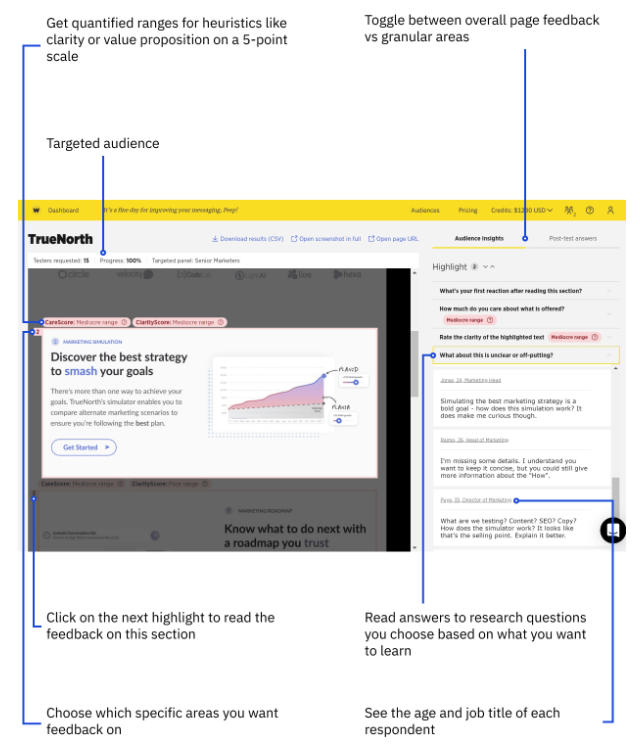
Knowing exactly where your messaging falls short makes it much easier to edit and personalize for specific target audiences. More relevant, compelling messaging ultimately boosts conversion results.
Quantitative data
Once you get qualitiative data, dive into your free trial data to understand the aha moments and friction points. Uncover these moments with either an analytics platform or product-led platform.
Analytics platforms
Product analytics software like Pendo and Mixpanel can reveal subtle differences between the users who do convert and those who don’t一behaviors you might not perceive just by watching.
Pendo
Pendo helps companies improve users’ experience with their software by sharing what customers are doing, collecting feedback about how they feel about the product, and providing helpful in-app messages.
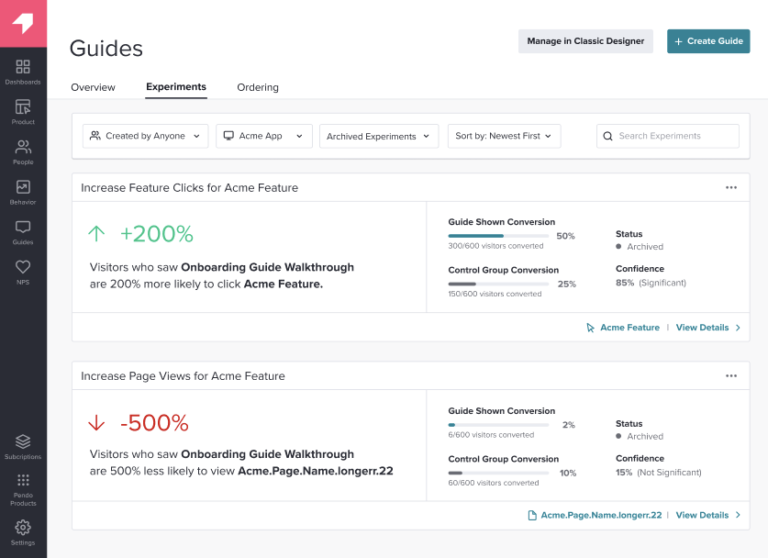
Pendo users boost their conversion rates by:
- Tracking product usage
- Setting benchmarks for customer health
- Uncovering leading indicators of conversion
- Setting conversion targets (features, pages, events)
- Sharing in-app guides with the right users at the right time
- Determining what works and what doesn’t with Pendo’s reporting capabilities
Mixpanel
Mixpanel is a leading product analytics company that tracks acquisition, conversion, and retention behavior within a company’s product.
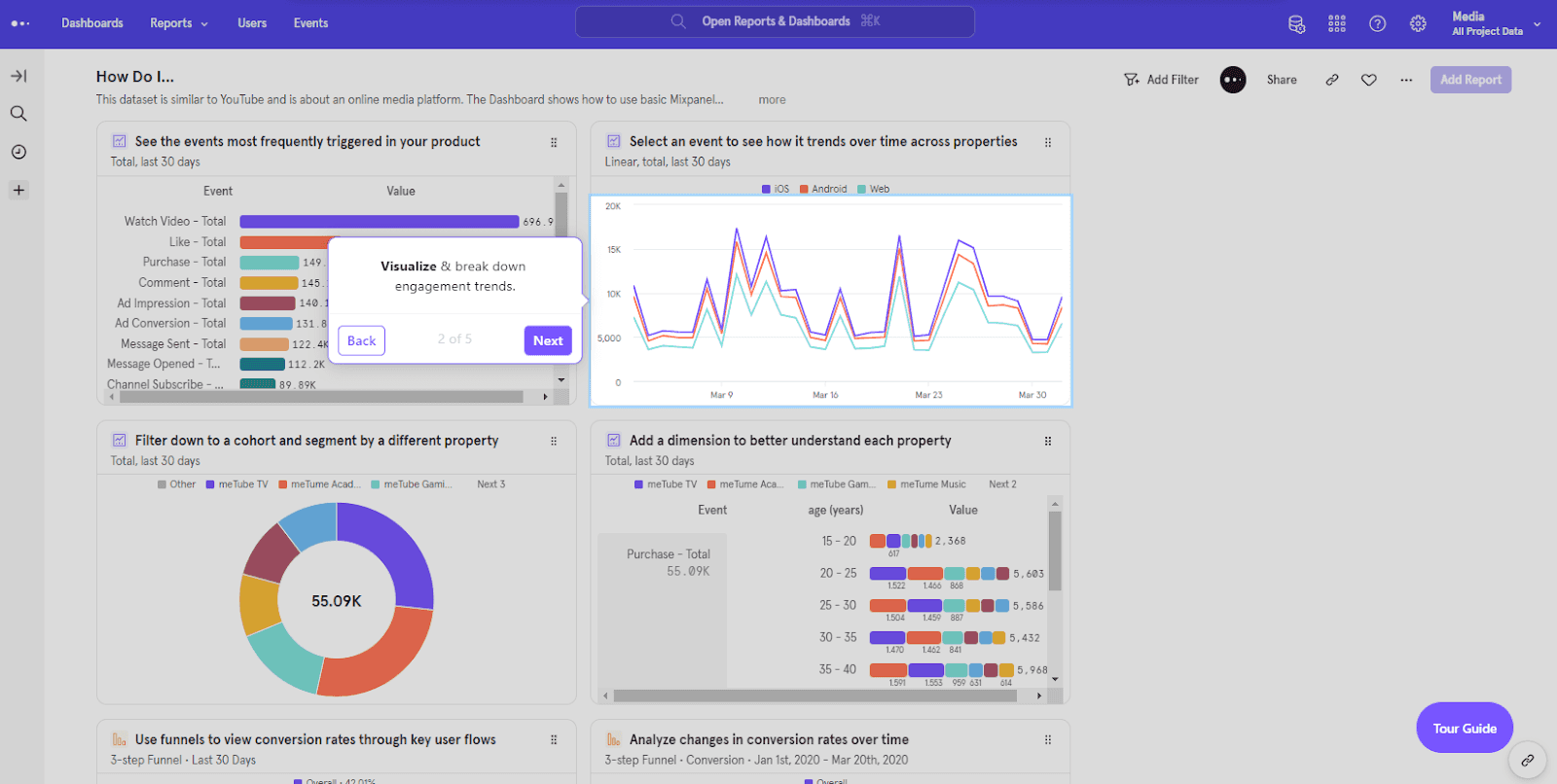
Mixpanel helps users improve their conversion rates by:
- Defining and tracking conversion at each stage of the funnel
- Comparing conversion paths of people that convert against people that don’t
- Understand which assets or features impress certain audiences
- Sending targeted messages to avoid drop-off
- Measure key conversion rate KPIs
Product-led automation platforms
You might find that users that convert begin using their free trial instantly or complete specific tasks within the first few days. With that in mind, you can brainstorm new ways to encourage free trial users to perform those actions faster.
Free trial data can also surface product qualified leads, otherwise known as PQLs. Tools like Correlated, Pocus, and Breadcrumbs can help you identify and reach out to highly engaged PQLs, ultimately driving conversions.
Correlated
Correlated leverages AI to uncover highest propensity PQLs and send them to your sales team.

Correlated’s customers use the tool to:
- Review and implement actionable product and CRM insights
- Identify users who are ready to buy
- Intelligently segmenting audiences
- Use Correlated’s playbook builder to define signals and automate next best actions
Pocus
Pocus is a product-led sales platform that enables go-to-market teams with product usage data without having to involve engineers.

Within the platform, users can:
- Define product qualified leads
- Measure customer fit, product usage, and buying intent
- Conduct experiments against in-app workflows
Breadcrumbs
Breadcrumbs centralizes data scattered across an organization to empower users to better understand prospect and customer behavior with actionable insights.

Users increase conversion rate by using these Breadcrumbs features:
- Lead scoring and prioritization
- Custom scoring models for each stage of the funnel
- Hidden intent signal analysis
Way #3: A/B test existing experiences
A/B testing gives you an opportunity to test two different customer experiences to refine your free trial in a data-driven way.
While you can’t always land on the money the first time, you can eventually hit the jackpot with enough experimentation. Here are several tests you might run related to free trials:
- Different in-app messaging and CTAs
- Onboarding emails
- A-ha moments
- Product tour videos against interactive demos
Trainual, a business playbook software, needed a way to get users to a lightbulb moment before even starting a free trial, and communicate the value of their product earlier in the evaluation process.
To achieve these goals, they decided to test product tour videos and interactive demos. They let the test run for a few weeks to gain enough data and set up their KPIs — number of free trial signups and number of highly-engaged users.
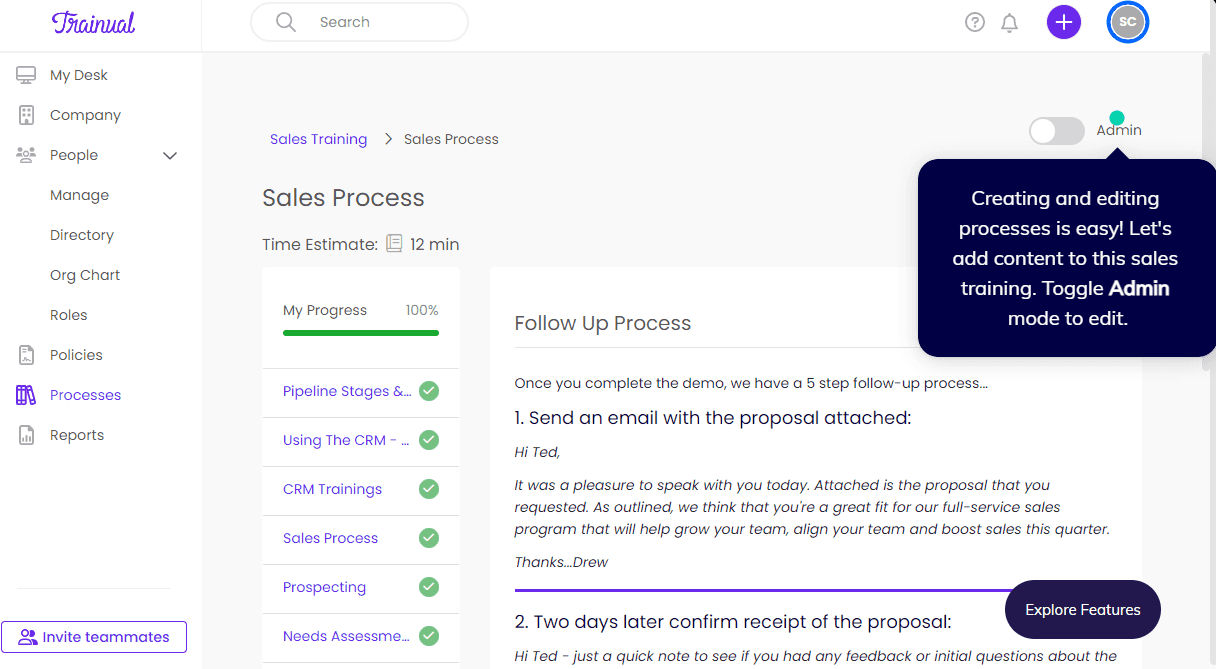
Ultimately, they saw a +450% lift in free trial signups when the interactive demo was displayed and a +100% increase in users reaching activated trial status seven days after signup.
Even better, Trainual had a +175% lift in users converting to paid customers in that same timeframe.
Way #4: Drive users towards a-ha moments and unblock friction points
User research should expose points in the free trial cycle where your product delights your users and proves your product’s value. That is what we call an “a-ha moment”.
A-ha moments often have a high correlation between feature adoption and retention; when customers know your product works and has value, they’ll keep using it.
There are several techniques you can use to guide users toward these a-ha moments. Let’s review the pros and cons of each.
In-app guides
Short, informative messages strategically placed in a free trial. Product walk-throughs can help users adopt your product and understand its value faster.
Pros
- Users get guidance while in the product, sending them straight to a-ha moments
- Usually in-app guides are no-code solutions
Cons
- Messages can sometimes be distracting to users
- Users won’t see in-app guidance unless they’re using the free trial
Tips to optimize
- Include a checklist or way for users to go back to the in-app guidance if they want to
- Layer in interactive demos in your product in-app guidance — giving the option to explore your product for themselves or see a guided product tour
- Use tools like Appcues or Userguiding to boost activation and create stickiness
Email communications
You can set up email sequences to remind users to log into your free trial and link them straight to where you know they will have that a-ha moment.
Pros
- Users don’t have to be in the app to receive guidance
- Email gives you more room for explanation than a pop-up bubble
Cons
- Users can get overwhelmed with emails
- Email takes the user out of the product
Tips to optimize
- Don’t send emails too frequently
- Send emails based on in-app event-based actions, not on a random cadence
- Use a product-led automation platform to send emails to the most valuable prospects
UI updates
While the most engineering lift, updating the actual product ensures most users see success within the free trial without additional guidance or communications.
Pros
- Most effective way to get users to do something is to change the UI itself
- Can’t be exited or ignored
Cons
- Requires significant engineering resources
- Takes the longest time to set up
Tips to optimize
- Beta test your UI
- Get feedback from internal testers before launch
- Use a user feedback tool for external commentary
Way #5: Educate users on your product earlier in the buyer cycle
A fantastic way to get users excited about your product is to introduce it right away with an ungated interactive experience.
Only 3 - 5% of website visitors actually sign up for a free trial, inherently limiting your audience.
An ungated demo let’s anyone see how your product works. You can then use product analytics or product-led automation tools to weed out the people just poking around and hone in on the activated accounts.
Plus, interactive demos have between a 25 - 40% engagement rate. That means every one in 3 or 4 users who interact with your landing page will see your product.
A great example of this in practice is Autobound’s ungated interactive demo. Autobound realized that early prospects weren’t grasping the product’s value by reading content on their website. Reps were spending an excessive amount of time educating users on every call.
So they decided to insert a product tour right on their homepage to teach customers about Autobound ahead of time:
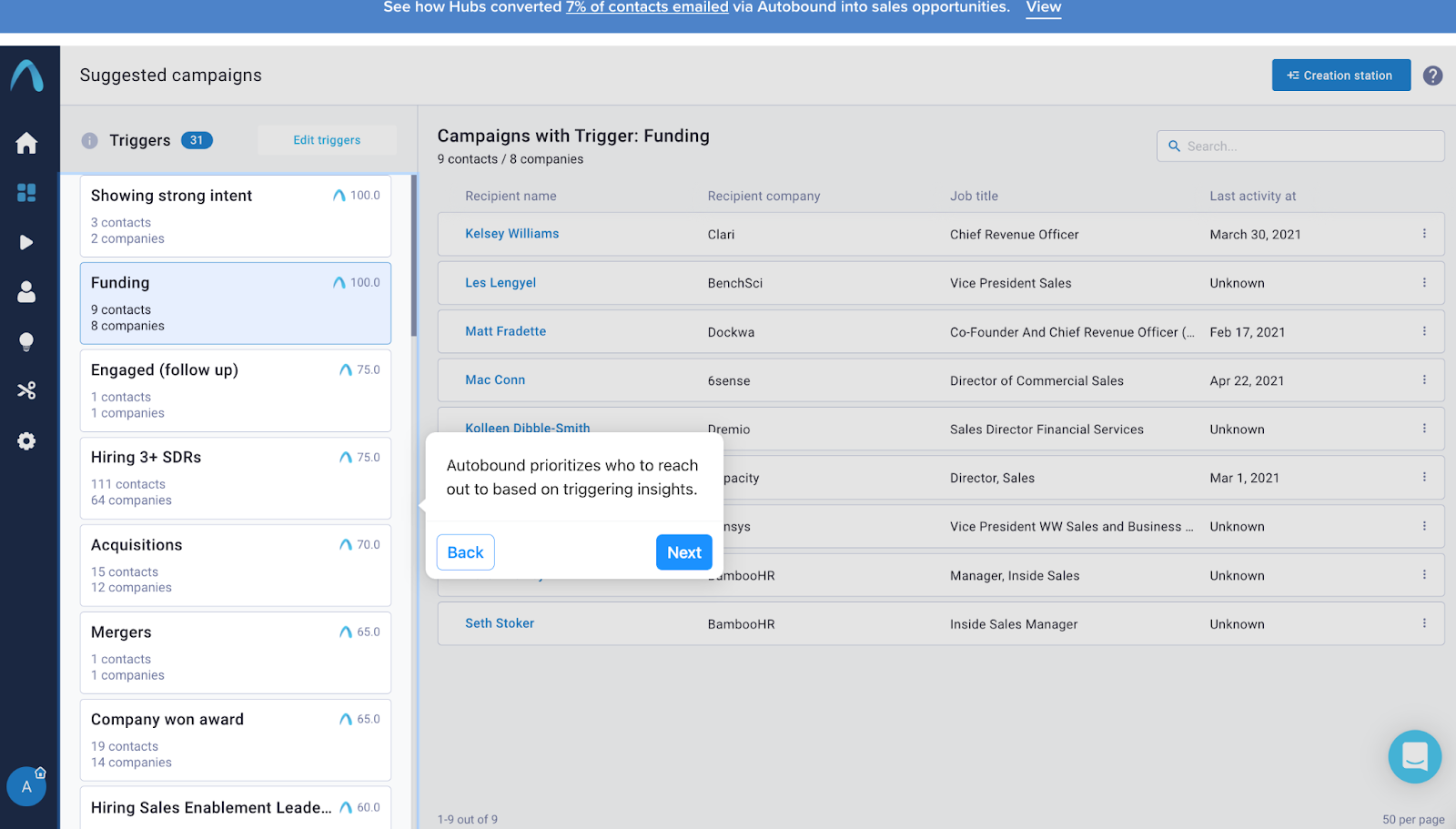
Doing so tripled Autobound’s free trial conversions. And because prospects already had a sense of what they should expect, they found their a-ha moments sooner and were much more likely to take a sales meeting.
Ultimately, previewing Autobound’s value with an interactive product demos led to more closed deals.
For more tips on how to build momentum pre sign up see Appcues Product Adoption Academy course.
Way #6: Make it easier to integrate your data
Integrations are often a key blocker to seeing value within a free trial experience.
Creating videos, walkthroughs or interactive demos can show users what the fully integrated product looks like and what it can do. These resources can also demonstrate how easy setup is and get users excited about doing it.
Rollworks, an account-based marketing platform, is an excellent example. Their Help Center has detailed, helpful, step-by-step walkthroughs of how to set up an integration.
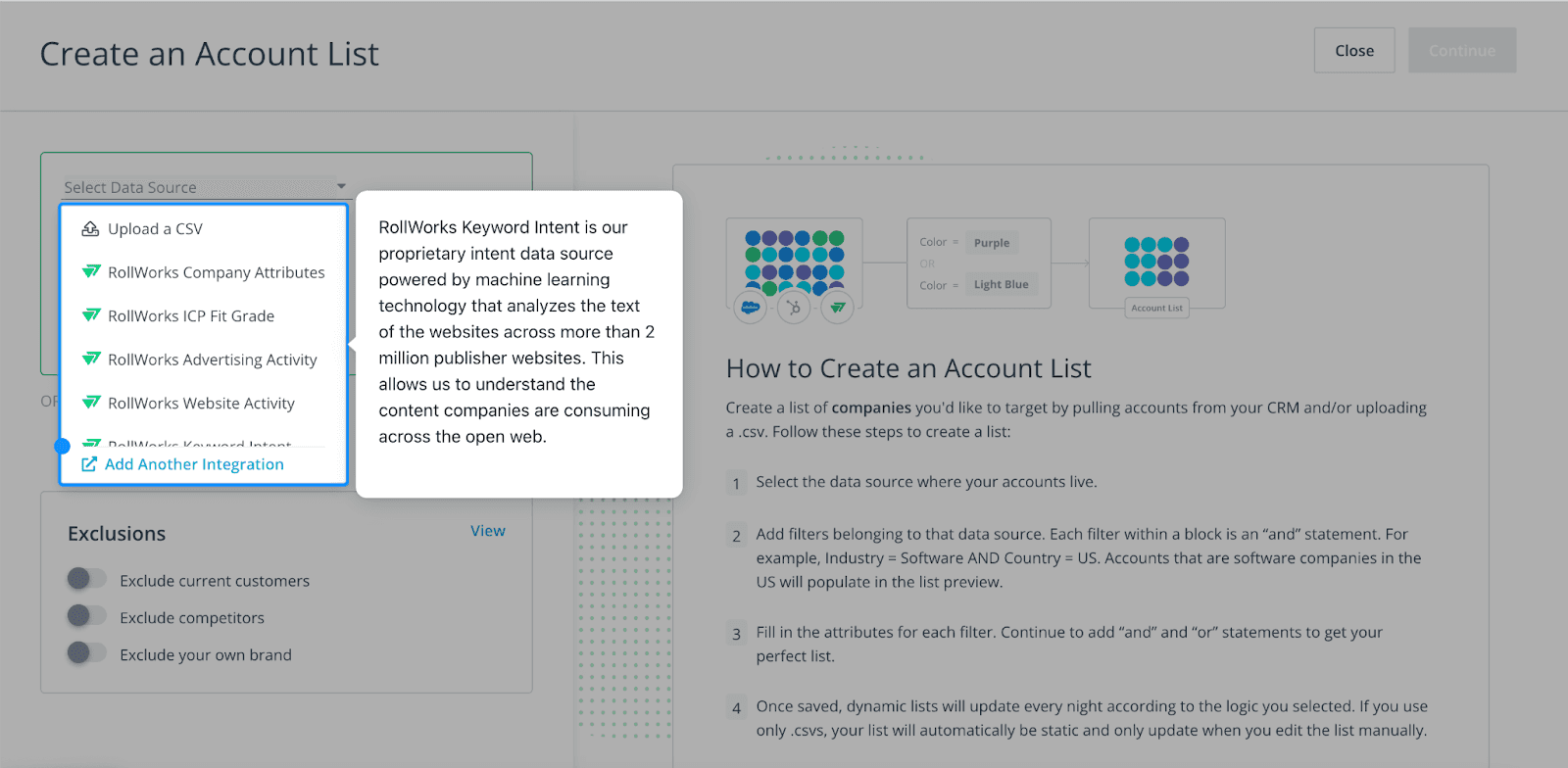
They include side-by-side screenshots as well so the user can confirm they are on the right track during the implementation.
Klue, a competitive enablement platform, creates a colorful, exciting landing page for their integrations. On it, they provide screenshots, explain what a Microsoft Teams and Klue integration looks like, and

The page also has an embedded interactive tour to show how to send messages to Klue, including important context that will be shown in Klue users’ Alerts feed.
Atlhough many companies are just getting started with product-led content, it has tremendous potential. Not only does it get prospects’ hands on your product earlier, it also allows them to do research on their own terms, building up the trust required to convert them into a happy customer organically.